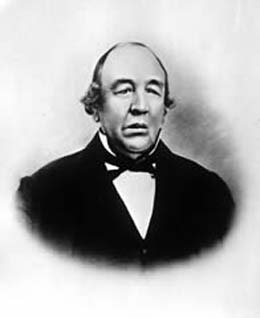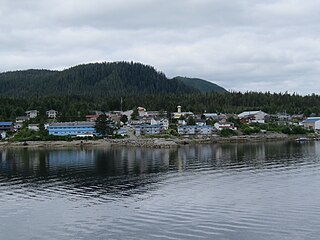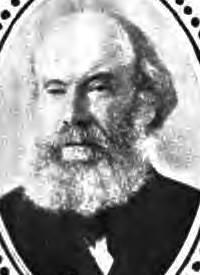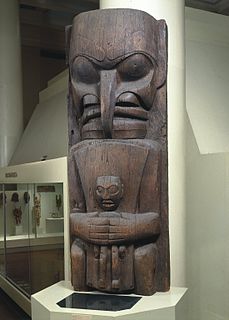Related Research Articles

John McLoughlin, baptized Jean-Baptiste McLoughlin, was a French-Canadian, later American, Chief Factor and Superintendent of the Columbia District of the Hudson's Bay Company at Fort Vancouver from 1824 to 1845. He was later known as the "Father of Oregon" for his role in assisting the American cause in the Oregon Country. In the late 1840s, his general store in Oregon City was famous as the last stop on the Oregon Trail.

Fort Vancouver was a 19th-century fur trading post that was the headquarters of the Hudson's Bay Company's Columbia Department, located in the Pacific Northwest. Named for Captain George Vancouver, the fort was located on the northern bank of the Columbia River in present-day Vancouver, Washington. The fort was a major center of the regional fur trading. Every year trade goods and supplies from London arrived either via ships sailing to the Pacific Ocean or overland from Hudson Bay via the York Factory Express. Supplies and trade goods were exchanged with a plethora of Indigenous cultures for fur pelts. Furs from Fort Vancouver were often shipped to the Chinese port of Guangzhou where they were traded for Chinese manufactured goods for sale in the United Kingdom. At its pinnacle, Fort Vancouver watched over 34 outposts, 24 ports, six ships, and 600 employees. Today, a full-scale replica of the fort, with internal buildings, has been constructed and is open to the public as Fort Vancouver National Historic Site.

Oregon Country was a disputed region of the Pacific Northwest of North America in the 19th century. The region was occupied by British and French Canadian fur traders from before 1810, as well as American settlers from the mid-1830s, with its coastal areas north from the Columbia River frequented by ships from all nations engaged in the maritime fur trade, most of these from the 1790s through 1810s being Boston-based. The Oregon Treaty of 1846 ended disputed joint occupancy pursuant to the Treaty of 1818 and established the British-American boundary at the 49th parallel.

Fort Astoria was the primary fur trading post of John Jacob Astor's Pacific Fur Company (PFC). A maritime contingent of PFC staff was sent on board the Tonquin, while another party traveled overland from St. Louis. This land based group later became known as the Astor Expedition. Built at the entrance of the Columbia River in 1811, Fort Astoria was the first American-owned settlement on the Pacific coast of North America.

John Work was a Chief Factor of the Hudson's Bay Company and head of one of the original founding families in Victoria, British Columbia. Work joined the Hudson's Bay Company in 1814 and served in many capacities until his death in 1861, ultimately becoming a member of the company's Board of Management for its Western Department. He also served on Vancouver Island’s Legislative Council. At the time of his death, Work was the largest private land owner of Vancouver Island. Work left an important legacy in the form of sixteen journals which chronicle his trading expeditions from 1823 to 1851. His journals provide a detailed record of Pacific Northwest land features, native peoples, and the Hudson’s Bay Company’s fur trading business in the early 19th century.

Bella Bella, also known as Waglisla, is the home of the Heiltsuk and is an unincorporated community and Indian reserve community located within Bella Bella Indian Reserve No. 1 on the east coast of Campbell Island in the Central Coast region of British Columbia, Canada. Bella Bella is located 98 nautical miles (181 km) north of Port Hardy, on Vancouver Island, and 78 nautical miles (144 km) west of Bella Coola. The community is on Lama Passage, part of the Inside Passage – a transportation route linking the area, and northern British Columbia as well as Alaska for marine vessels carrying cargo, passengers and recreational boaters from the south coast.
Bella Bella may refer to:

The Heiltsuk or Haíɫzaqv, sometimes historically referred to as Bella Bella, are an Indigenous people of the Central Coast region in British Columbia, centred on the island community of Bella Bella. The government of the Heiltsuk people is the Heiltsuk Nation, though the term is also used to describe the community. Its largest community is Bella Bella.

The Columbia District was a fur trading district in the Pacific Northwest region of British North America in the 19th century. Much of its territory overlapped with the disputed Oregon Country. It was explored by the North West Company between 1793 and 1811, and established as an operating fur district around 1810. The North West Company was absorbed into the Hudson's Bay Company in 1821 under which the Columbia District became known as the Columbia Department. The Oregon Treaty of 1846 marked the effective end of the Hudson's Bay Company's Columbia Department.
The Puget Sound Agricultural Company (PSAC), with common variations of the name including Puget Sound or Puget's Sound, was a subsidiary joint stock company formed in 1840 by the Hudson's Bay Company (HBC). Its stations operated within the Pacific Northwest, in the HBC administrative division of the Columbia Department. The RAC-HBC Agreement was signed in 1839 between the Russian-American Company and the HBC, with the British to now supply the various trade posts of Russian America. It was hoped by the HBC governing committee that independent American merchants, previously a major source of foodstuffs for the RAC, would be shut out of the Russian markets and leave the Maritime fur trade.

William Fraser Tolmie was a surgeon, fur trader, scientist, and politician.

Milbanke Sound is a sound on the coast of the Canadian province of British Columbia.
Alexander Roderick McLeod was a fur trader and explorer in British North America who began his career with the North West Company in 1802.

The York Factory Express, usually called "the Express" and also the Columbia Express and the Communication, was a 19th-century fur brigade operated by the Hudson's Bay Company (HBC). Roughly 4,200 kilometres (2,600 mi) in length, it was the main overland connection between HBC headquarters at York Factory and the principal depot of the Columbia Department, Fort Vancouver.
Thomas McKay (1796–1849) was an Anglo-Métis Canadian Fur trader who worked mainly in the Pacific Northwest for the Pacific Fur Company (PFC), the North West Company (NWC), and the Hudson's Bay Company (HBC). He was a fur brigade leader and explorer of the Columbia District and later became a U.S. citizen and an early settler of Oregon.
Fort Simpson was a fur trading post established in 1831 by the Hudson's Bay Company (HBC) near the mouth of the Nass River in present-day British Columbia, Canada. In 1834, it was moved to the Tsimpsean Peninsula, about halfway between the Nass River and the Skeena River, and was later referred to as Port Simpson or as the native name Lax Kw'alaams. The fort was part of the HBC's Columbia Department.
Fort Stikine was a fur trade post and fortification in what is now the Alaska Panhandle, at the site of the present-day of Wrangell, Alaska, United States. Originally built as the Redoubt San Dionisio or Redoubt Saint Dionysius in 1834, the site was transferred to the British-owned Hudson's Bay Company as part of a lease signed in the region in 1838, and renamed Fort Stikine when turned into a Hudson's Bay Company post in 1839. The post was closed and decommissioned by 1843 but the name remained for the large village of the Stikine people which had grown around it, becoming known as Shakesville in reference to its ruling Chief Shakes by the 1860s. With the Alaska Purchase of 1867, the fortification became occupied by the US Army and was renamed Fort Wrangel, a reference to Baron von Wrangel, who had been Governor of Russian America when the fort was founded. The site today is now part of the city of Wrangell.

Old Bella Bella, also known as Old Towns or Qlts, was the name for the Heiltsuk village that grew up around the Hudson's Bay Company's historic Fort McLoughlin, at McLoughlin Bay on Campbell Island. The village relocated to the present site of Bella Bella, British Columbia by 1903. Today the Heiltsuk control the site, which houses a BC Ferries terminal, fish plant, and two houses, as well as archaeological remains of the old village.
Joseph William McKay (Mackay) was a fur trader, businessman, politician and explorer who had a long career in the employ of the Hudson's Bay Company in Canada.
Isabella Mainville Ross was the first female registered landowner in British Columbia. She was a Métis woman, the daughter of Joseph and Josette Mainville.
References
- ↑ "Bella Bella (community)". BC Geographical Names .
- ↑ "McLoughlin Bay". BC Geographical Names .
- ↑ "McLoughlin Creek". BC Geographical Names .
- ↑ "McLoughlin Lake". BC Geographical Names .
- ↑ Mackie, Richard S. Trading Beyond the Mountains: The British Fur Trade on the Pacific 1793-1843. Vancouver, B.C.: University of British Columbia Press. 1997, pp. 125-126. ISBN 0-7748-0613-3.
- 1 2 3 Mackie (1997), pp. 132–134.
- ↑ Tolmie, William Fraser (1963). Physician and Fur Trader. Vancouver: Mitchell Press Limited.
- ↑ Koppel, Tom. Kanaka, the Untold Story of Hawaiian Pioneers in British Columbia and the Pacific Northwest. Vancouver, B.C.: Whitcap Books. 1995, p. 52.
- ↑ Walbran, Captain John T. British Columbia Coast Names: 1592-1906 Their Origin and History. 1971. ISBN 0-295-97142-8
- ↑ Mackie (1997), pp. 269–270.
- ↑ Large, R. Geddes (1968). Drums and Scalpel: From Native Healers to Physicians on the North Pacific Coast. Vancouver: Mitchell Press Limited. p. 4.
- ↑ Bancroft, Hubert Howe; Nemos, William; Bates, Alfred (1887). "History of British Columbia, 1792-1887". San Francisco: The History Co.: 59, 93, 100 & 193.
{{cite journal}}: Cite journal requires|journal=(help) - 1 2 Large, R. Geddes (1968). Drums and Scalpel: From Native Healer to Physician on the North Pacific Coast. Vancouver: Mitchell Press Limited. p. 4.
Coordinates: 52°09′43″N128°08′42″W / 52.16194°N 128.14500°W